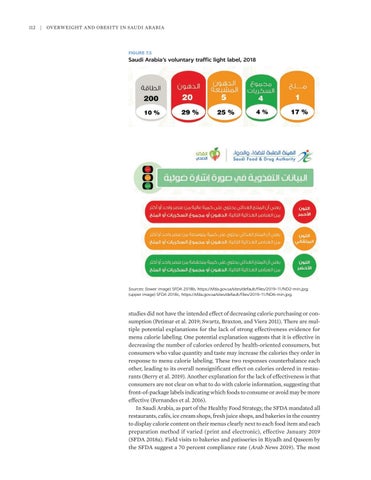112
|
Overweight and Obesity in Saudi Arabia
FIGURE 7.5
Saudi Arabia’s voluntary traffic light label, 2018
Sources: (lower image) SFDA 2018b, https://sfda.gov.sa/sites/default/files/2019-11/ND2-min.jpg; (upper image) SFDA 2018c, https://sfda.gov.sa/sites/default/files/2019-11/ND6-min.jpg.
studies did not have the intended effect of decreasing calorie purchasing or consumption (Petimar et al. 2019; Swartz, Braxton, and Viera 2011). There are multiple potential explanations for the lack of strong effectiveness evidence for menu calorie labeling. One potential explanation suggests that it is effective in decreasing the number of calories ordered by health-oriented consumers, but consumers who value quantity and taste may increase the calories they order in response to menu calorie labeling. These two responses counterbalance each other, leading to its overall nonsignificant effect on calories ordered in restaurants (Berry et al. 2019). Another explanation for the lack of effectiveness is that consumers are not clear on what to do with calorie information, suggesting that front-of-package labels indicating which foods to consume or avoid may be more effective (Fernandes et al. 2016). In Saudi Arabia, as part of the Healthy Food Strategy, the SFDA mandated all restaurants, cafés, ice cream shops, fresh juice shops, and bakeries in the country to display calorie content on their menus clearly next to each food item and each preparation method if varied (print and electronic), effective January 2019 (SFDA 2018a). Field visits to bakeries and patisseries in Riyadh and Qaseem by the SFDA suggest a 70 percent compliance rate ( Arab News 2019). The most






